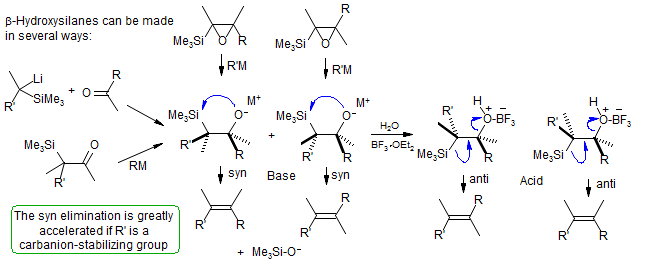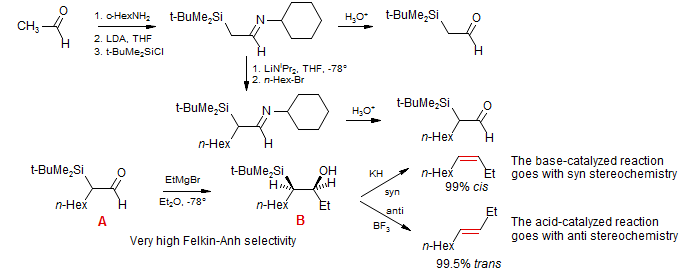The Peterson Olefination
"Alkene Synthesis via β-Functionalized Organosilicon Compounds,"
T. H. Chan, Acc. Chem. Res. 1977, 10, 442.
"The Peterson Olefination Reaction,"
Ager, D. J. Synthesis 1984, 384; Org. React. 1990, 38, 1.
"Recent Studies on the Peterson Olefination Reaction,"
Barrett, A. G. M.; Hill, J. M.; Wallace, E. M.; Flygare, J. A. Synlett 1991, 764.
"α,β-Epoxysilanes,"
Hudrlik, P. F.; Hudrlik, A. M. Advances in Silicon Chemistry. Vol. 2. G. L. Larson, Ed., Jai Press: Greenwich, CT, 1993.
"New Developments in the Peterson Olefination Reaction,"
van Staden, L. F.; Gravestock, D.; Ager, D. J. Chem. Soc. Rev. 2002, 31, 195-200.
In the Peterson olefination, a β-hydroxy silane decomposes to form an olefin and a silanol under the influence of acid or base. The β-hydroxy silane can be prepared in a number of ways, including addition of α-silyllithium reagents to carbonyl compounds, reduction or organometallic addition to α-silyl ketones, nucleophilic opening of silyl epoxides, or reaction of silyllithium reagents with epoxides.

In its simplest form, the Peterson olefination involves the addition of a trimethylsilyl-substituted methyllithium or magnesium reagent to a ketone or aldehyde, to introduce a methylene group. The reagent can be made in the conventional way from the bromide (Br-CH2-SiMe3). For systems where the silyl-bearing carbon has only alkyl or H substituents (i.e. no carbanion stabilizing groups) the β-hydroxy silanes are stable and can be isolated. The elimination can be induced either by treatment with fluoride, with acid, or with strong base. Shahamin K: Lebsack, A. D.; Overman, L. E.; Valentkovitch, R. J. J. Am. Chem. Soc. 2001, 123, 4851.

When the silyl-bearing carbon has carbanion stabilizing groups, such as carbonyl groups, or the two S-substituents in the example below, the elimination reaction is fast, and the hydroxy-silanes can no longer be easily isolated. Clovene: Funk, R. L.; Novak, PM.; Abelman, M. M Tetrahedron Lett. 1988, 29, 1493.

This effect of anion-stabilizing groups R at the silyl-bearing carbon to increase the rate of cycloelimination of alkoxy silanes (also seen for phosphonates) is presumably the result of significant development of negative charge as the Si-C bond is broken during the elimination reaction. The rate is increased if R stabilizes negative charge.

α-Silyl aldehydes can act as vinyl cation equivalents, as in the example below, where a vinyl group is appended α to a ketone enolate (Hudrlik, J. Am. Chem. Soc., 1981, 103, 6251).

Stereochemistry of the Peterson Olefination. β-Hydroxy silanes can be converted to olefins either by treatment with base, through a four-membered cyclic silaoxetane, in a strictly syn-elimination, or by treatment with acid, more analogous to an E2 elimination, with strctly anti stereochemistry. Thus if β-hydroxy silanes can be formed with high stereoselectivity, either Z- or E-alkenes can be formed from a single diastereomer. In the example below, the α-silyl aldehyde A undergoes a very high Felkin-Anh-selective addition with ethylmagnesium bromide, forming an essentially pure diastereomer B. Treatment with acid or base gives Z and E alkene, respectively (Hudrlik, J. Am. Chem. Soc., 1981, 103, 6251).

Examples of the Peterson Olefination
Stipiamide, 6,7-Dehydro: Zeng, X.; Zeng, F.; Negishi, E. Org. Lett. 2004, 6, 3245-3248

Roseophilin: Harrington, P. E.; Tius, M. A. J. Am. Chem. Soc. 2001, 123, 8509-8514

Laurenyne: Overman, L. E.; Thompson, A. S. J. Am. Chem. Soc. 1988, 110, 2248

Conduritol B, F: Heo, J. N.; Holson, E. B.; Roush, W. R. Org. Lett. 2003, 5, 1697-1700

Warburganal: Kende, A. S.; Blacklock, T. J. Tetrahedron Lett. 1980, 21, 3119
